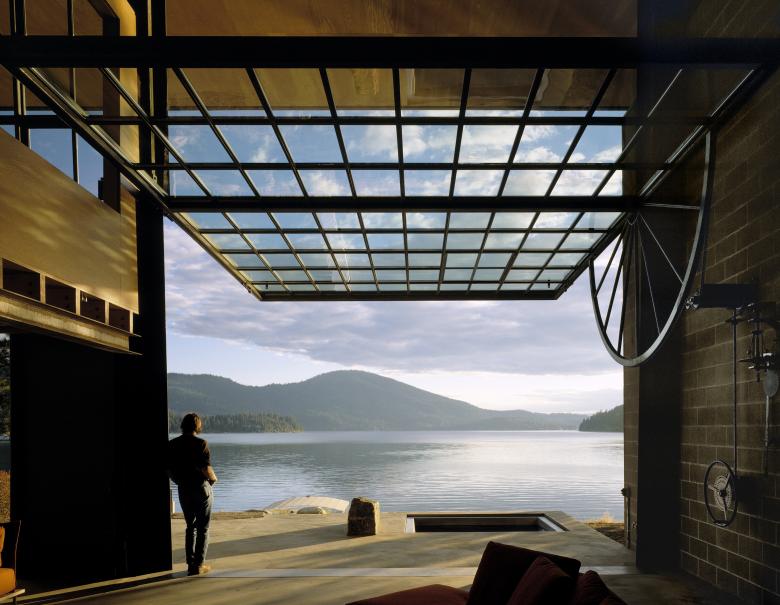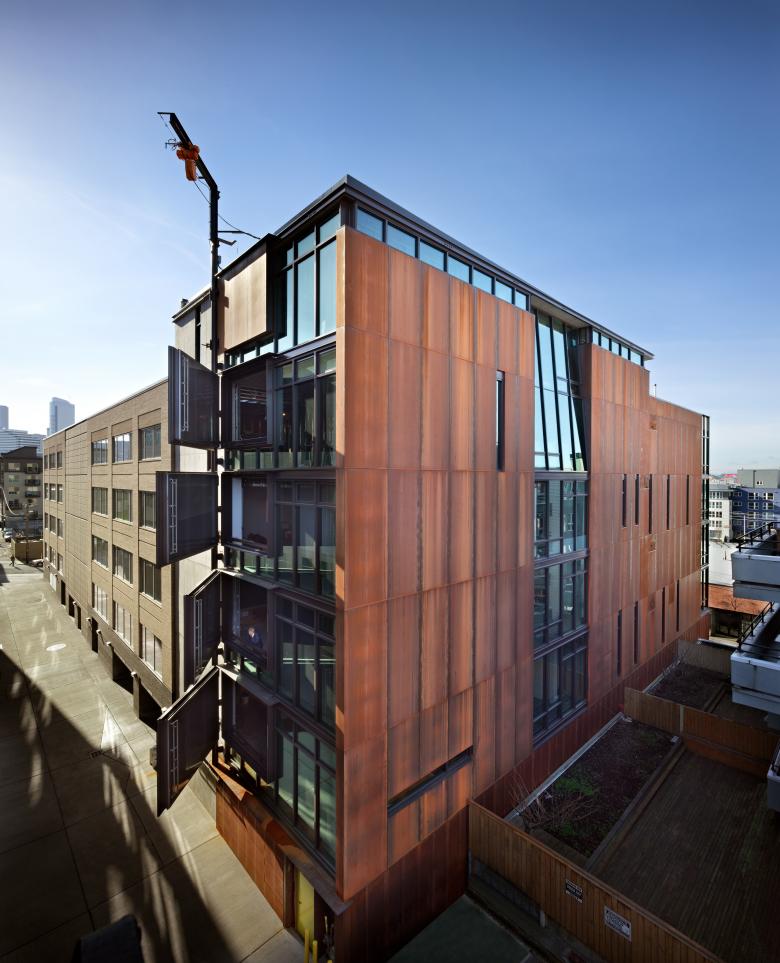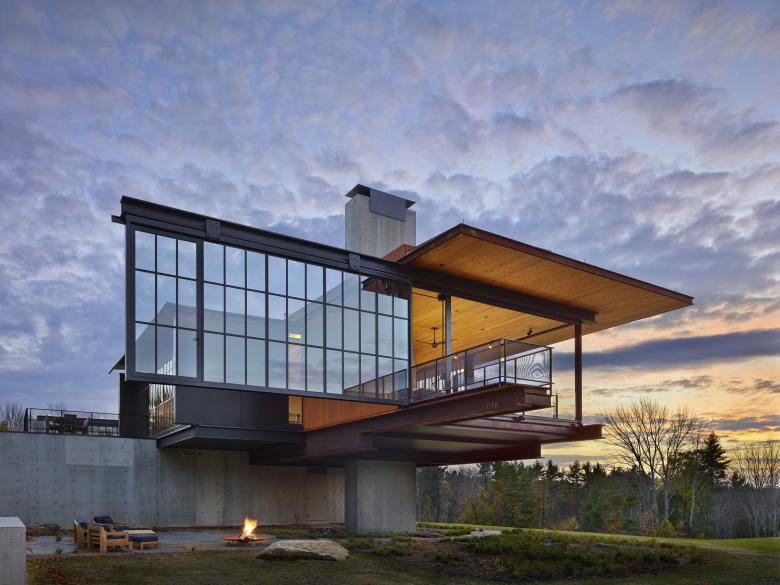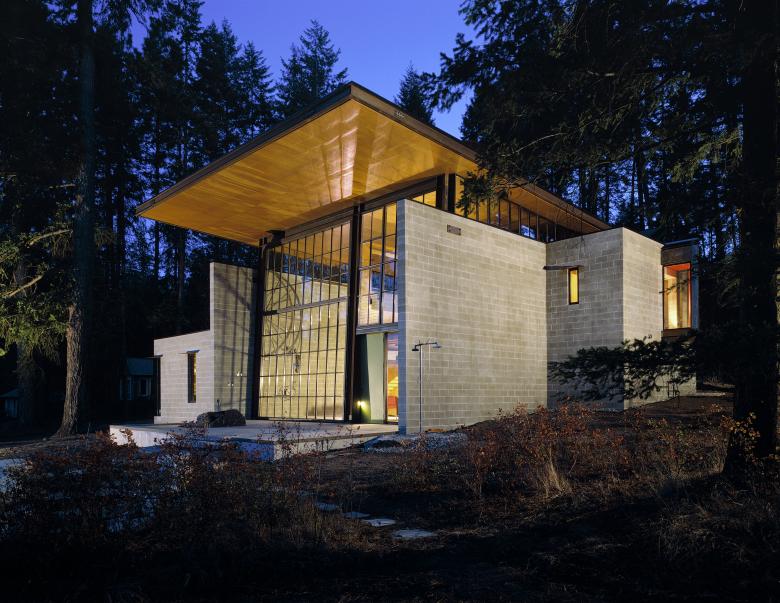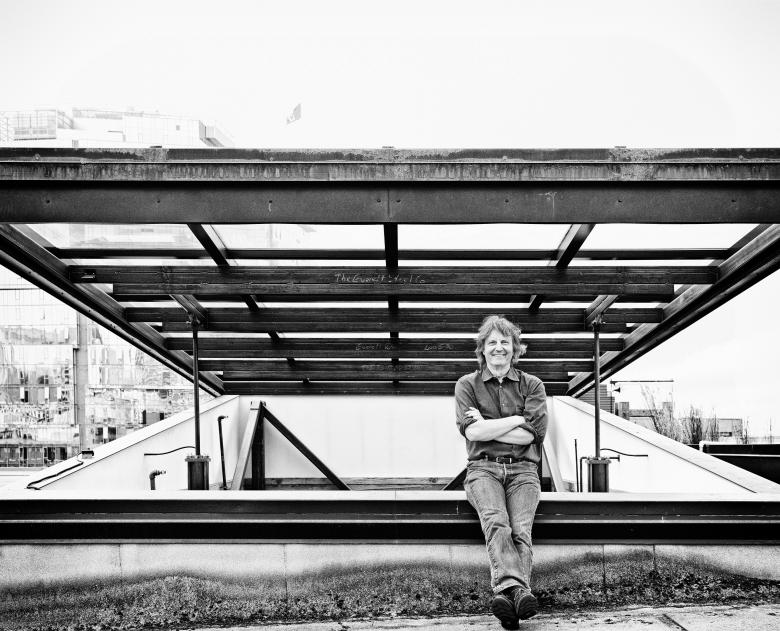While Tom Kundig was designing Chicken Point Cabin in Northern Idaho in 2003, the opportunity arose to explore opening up buildings with moving parts, something that became a recurring and instantly recognizable theme of his buildings. A captivating photo of the front wall of the house lifted by a clock-like contraption on the right, balanced by the architect himself on the left, standing with his back to the camera, admiring a peaceful view of tree-covered mountains reflected in the gentle ripple of the lake’s surface, captures earnestly the essentials of Kundig’s architecture: a sense of realness, the mechanics of things, harnessing nature, and — above all — risk-taking.
Kundig was born in 1954 in Merced, California, where his parents had moved from Switzerland shortly after World War II. The family then relocated to Spokane in eastern Washington where Tom’s father, Moritz Kundig, a practicing architect, found a job. His mother worked at a mid-century modern housewares and furniture store, which facilitated constant exposure for Tom to that era’s interiors and furniture, in addition to the modern buildings that his father was designing. In his teenage years, Kundig worked as a grinder at the studio of artist Harold Balazs, a family friend. He initially studied geophysics at the University of Washington but as a sophomore switched to architecture, earning a Bachelor of Arts in Environmental Design in 1977 and then a Master of Architecture in 1981, also from the University of Washington. In between his degrees and after his graduation, Kundig worked for local firms as well as in Switzerland. He obtained his professional license in Washington State and ran his own firm, Jochman/Kundig Partnership, with a partner for a couple of years in Alaska, where he also got licensed.
In 1986, Kundig joined Olson/Sundberg Architects (it was renamed from Olson / Walker Architects one year before). He became one of the firm’s owners in 2000 when it changed to Olson Sundberg Kundig Allen or OSKA. In 2008, the practice became Olson Kundig Architects and since 2015 it has been known as Olson Kundig. The architect is now registered to practice architecture in fifteen states. The 300-architect firm with 14 principals is based in Seattle, Washington, and has a satellite office in Manhattan. Its exquisitely designed and constructed buildings and interiors — single-family houses, condominiums, museums, cultural centers, offices, hotels, restaurants, and art and theater installations — are found in fifteen countries around the world. Kundig and I discussed the architect’s love for art and craftsmanship, his fascination with big machines and all kinds of gizmos, meeting his partner Jim Olson, what architecture is all about, and his client’s wish to make the Chicken Point Cabin as open as possible — a wish that changed everything.
Tom Kundig (TK): It became clear to me that my interests in mechanics, science, physics, and especially geophysics were not going to be enough. Something crucial was missing. I was already a sophomore at the University of Washington, taking all those physics courses when I started taking art and architecture classes. All of a sudden, I felt peaceful. That’s when I realized that some form of architecture was going to be important in my life. Before that, I was influenced by architecture but did not imagine myself being an architect.
TK: Harold was a good family friend. I grew up with his family even before I worked for him as a teenager. He became hugely impactful on me, especially for experimentation with materials: concrete, wood, steel, copper, brass, enamel, and so on. In his studio I absorbed his experimentation and material potential. I am still influenced by that experience. He fabricated all his sculptures himself, some quite large, and, therefore, he cared about his craft. I saw him working on all the nuances while he was making his pieces. I was just a grinder but I witnessed him crafting his works. That’s why I have a lot of respect for crafters.
I never met Tinguely, a Swiss sculptor, but his idea of taking machinery parts that you might find in a hardware store and assembling them into some sort of kinetic gizmo was beautiful. It was art and it was meaningful to me. Both Balazs and Tinguely were into hot-rod culture and so was l. Both of them accepted low-brow art as high-brow art. I also learned a lot from people who may not call themselves artists but, in fact, were doing something that’s super artistic. I consider myself extremely lucky because I met such artists as Peter Voulkos, Rudy Autio, and Edward and Nancy Kienholz, building with them these sorts of tribal totems, in a way, and celebrating that together with their families.
TK: Of course, I had heard of the firm Olson / Walker, run by Jim Olson and Gordon Walker, a partnership which was started in 1971. I knew their work since I was at school and I always saw it as very artistic. I remember being advised that first you need to work for a large firm, then for a small firm, before opening your own practice. That was the plan. So, when I graduated in 1981, I got my architectural license in Washington the next year, while working for a large firm. Then I went to Anchorage, Alaska, with a friend, where we started a small firm; it went on for a couple of years. In 1983, I obtained my Alaska license. It was a great place for work, as well as for mountain skiing and mountain climbing, which was always my passion. Our firm only lasted for a couple of years and I then came back to Seatle with the idea of working with a partner because I never wanted to be a solo practitioner; I need to be able to trade ideas. I felt Olson’s practice was the right firm for me. I could imagine my future with them.
TK: Every one of these words feels right. And it has to do with what I think is architecture, which is a real thing. It is not paper architecture and it is not academic architecture. Architecture is a thing that’s built, it is a thing that’s used, and it’s a thing that’s ages. Growing up with Herald Balazs I learned material properties and how to use tools, which I always saw as our own extensions, not as mere objects. So, for me, the architecture that I am intrigued by is the architecture of risk. It is the architecture that’s innovative and experimental but it is based on the reality of science, engineering, and culture; and what’s even more important for me is to turn every project into an advantage. Architecture is always about a new client, a new climate, a new landscape, and a new set of all kinds of unique issues that the architect is privileged to assemble, the way a conductor assembles individual efforts into a whole. I feel a part of such an assembly.
TK: Of course, authorship is important. You can sense it in all of my work. I will not deny that there is a particular DNA that drives all of these assemblies. But it is always a team effort to put things together. I am lucky to have a great support system here. And, honestly, there are some fantastic ideas that come out of the very process of collaboration. Of course, I always edit those ideas. And when designers come up with ideas that may not be right, I might suggest holding on to them and perhaps using them on other projects.
TK: Because I was a mountain climber and mountain skier, the natural landscape was always super important to me. As a kid, I remember going to silver mines and smelters, and I worked at lumber mills, seeing big trees getting cut down into pieces and sawdust. I was fascinated by these big machines’ hydraulics on the one hand. But, on the other hand, I recognized the incredible destruction of our natural landscapes by those devices. There is a conflict in that relationship. Still, I was fascinated with the machines, their efficiency, and their effectiveness.
TK: That came from my client’s wish to make the house as open to the water view as possible. That was Chicken Point Cabin in Hayden Lake in Northern Idaho, which was built in 2003, the one with a large pivoting picture window that literally opens the house to the water. Of course, when I was asked that, that’s when my experience with machinery became useful. I saw those big moving doors, big saws, and other devices. In a way, I just repurposed them for architecture.
TK: In a major way, yes. But I did use smaller devices before. I recognized early on that doors and windows were really interesting architecturally. Those are the parts of the buildings people touch and I thought a lot about repurposing them in many ways. So, I was doing big doors that moved, but the real audacious innovation came with Chicken Point because the client I worked with was particularly fun. We were on the site when he said, “Wouldn’t it be great if you could open the whole front end of the house to the water?” And I said, “I think we can!” [Laughs.] So, he was 100% with us, willing to take that risk to do that audacious thing and, hopefully, make it work because that was something we hadn’t seen before. I knew it would work because I had seen large objects being moved in other industries.
Another piece of luck was meeting Phil Turner at that very time. He is a gizmologist who works with us on designing kinetic elements. Phil was in that spirit. He was interested in risk and innovation and also had the talent to figure out some of the engineering ratios and the weight of things, the gearing of how things come together. Engineering-wise, those are his principles. I was with him, aesthetically. The aesthetics of those devices are mine.
